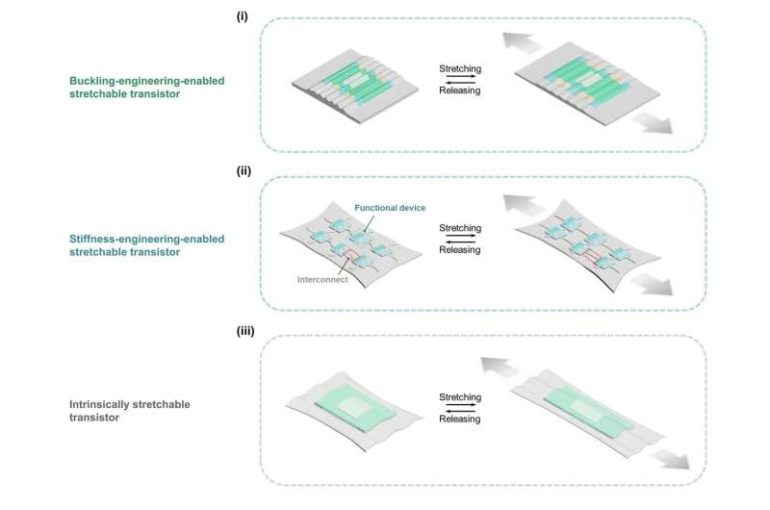Over the past few decades, researchers have been trying to develop electronic components that are increasingly flexible and skin-like, as these could enable the fabrication of new wearable and implantable devices. Transistors, semiconductors that can conduct and insulate electric current, are among the most vital components of contemporary electronics.
In recent years, engineers worldwide have fabricated numerous stretchable transistors using innovative design strategies and materials other than silicon. While some of these transistors have achieved promising results, so far, advancements and challenges in this area had not yet been exhaustively summarized.
With this in mind, researchers at the University of Chicago and Argonne National Laboratory wrote a review paper delineating the most common strategies used to develop stretchable transistors and the results achieved so far. Their paper, published in Nature Electronics, could serve as an important resource for other teams who are focusing on the development of flexible and wearable electronics.
“Our review paper mainly discusses three general strategies for building stretchable transistors,” Yahao Dai, a Ph.D. student in Sihong Wang’s research group and lead author for this paper. “We paid special attention to highlighting their different requirements in terms of material and device structure, which further determines the performance and applications of the resulting device.”
In addition to reviewing recent advances in the development of stretchable transistors, Wang and his colleagues outlined some of the challenges commonly encountered by researchers in the field. Their hope was to inspire the development of more effective solutions to circumvent or overcome these challenges.
“We developed a universal strategy to prepare highly stretchable and high-performance semiconducting materials through the nanoconfinement effect,” Sihong Wang, one of the researchers who carried out the study, told TechXplore. “Differently from traditional inorganic semiconductors, this kind of semiconductor exhibits high mobility, even being stretched to 100% for hundreds of cycles.”
Stretchable transistors are typically made of inherently flexible materials. This means that they can generally be fabricated simply by incorporating a number of flexible structures without the need for specially designed strain-dissipation structures. To fabricate electronics with more sophisticated capabilities, researchers typically use arrays of transistors.
In their previous works, Wang and his colleagues leveraged advances in patterning processes to fabricate an intrinsically flexible transistor array with a record-high density of 347/cm2. Miniature arrays of flexible transistors conform well with the human skin and can perform a variety of functions, ranging from sensing to using analog signals and multiplexing (i.e., sensing multiple signals or streams of information).
“We developed new materials and new fabrication methods to enable the construction of intrinsically stretchable functional transistor arrays that can seamlessly merge with human skin,” Wang said. “By forming a good tissue-electronic interface, we hope to eventually achieve high-quality biological signals recording in either an epidemic or in-vivo manner, which is expected to provide ubiquitous health care and deeper understanding of human biology.”
The recent review paper published in Nature Electronics is a concise summary of recent advances in the development of stretchable transistors. This summary could prove particularly valuable for other research teams who are trying to develop wearable and implantable technologies.
The ultimate goal of the work by Wang and his colleagues, just like that of other researchers in the field, is to fabricate implantable electronics that can simultaneously acquire, process and transmit signals with high levels of efficiency and reliability. In their future studies, the researchers plan to develop new functional and stretchable materials that can be integrated within a variety of electronic devices.
“We plan to use new material designs to integrate more biocompatible form factors into the current material library,” Wang said. “We also want to introduce new device structures and fabrication methods that can enable the reliable operation of devices within the human body. Finally, we would like to integrate our device with biocompatible power sources, data processing units and wireless transmitters to build a more completed system.”
With new design, stretchable electronics perform better under strain
More information:
Stretchable transistors and functional circuits for human-integrated electronics. Nature Electronics(2021). DOI: 10.1038/s41928-020-00513-5.
2021 Science X Network
Citation:
Researchers review advancements in the development of stretchable transistors (2021, February 8)
retrieved 8 February 2021
from https://techxplore.com/news/2021-02-advancements-stretchable-transistors.html
This document is subject to copyright. Apart from any fair dealing for the purpose of private study or research, no
part may be reproduced without the written permission. The content is provided for information purposes only.



